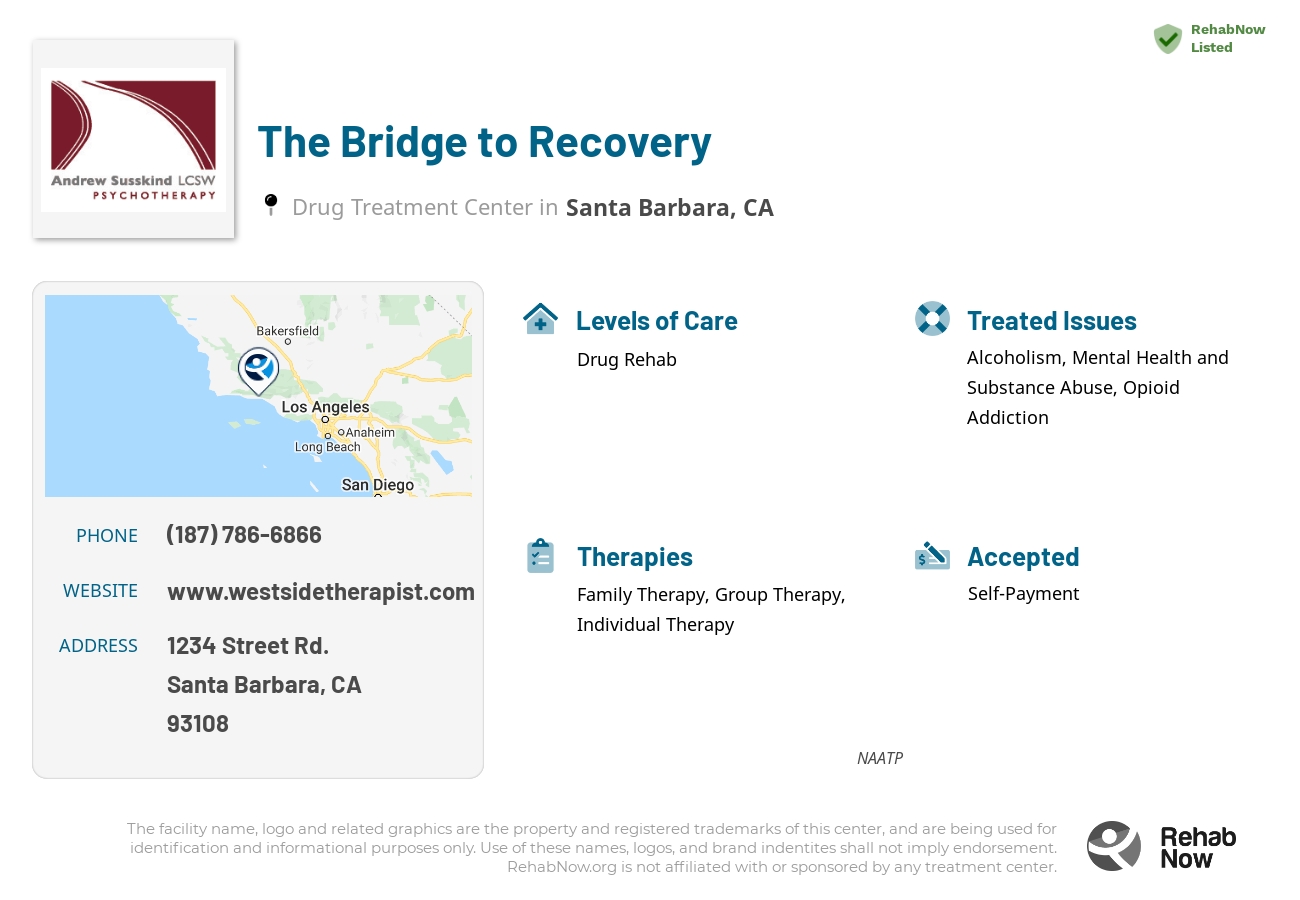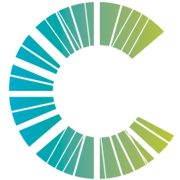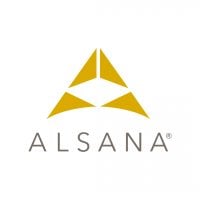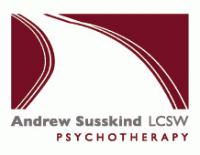
The Bridge to Recovery
Drug Rehab Center in Santa Barbara, California
- Opioid Addiction
- Dual Diagnosis
- Drug Addiction
- Alcoholism
The Bridge to Recovery is an award-winning Addiction Treatment Facility located in Santa Barbara, CA which offers a range of services to individuals struggling with addiction, while providing individualized care with experienced staff, private health insurance acceptance, and payment plan options.
Multiple patients have reported The Bridge to Recovery as permanently closed.
Research other rehabs in Santa Barbara, California, or get help finding an open facility.
Our experts will find you an alternative facility.
(888) 674-0062 24/7 Free, Confidential, Expert HotlineAbout The Bridge to Recovery in California
The Bridge to Recovery is a highly reputable treatment facility located in Santa Barbara, California. They are accredited by the National Association of Addiction Treatment Providers (NAATP), ensuring that they meet the highest standards of quality and professionalism. The facility specializes in treating individuals suffering from alcoholism, opioid addiction, dual diagnosis, and drug addiction. They offer a range of comprehensive services including drug rehab, outpatient care, inpatient programs, dual-diagnosis treatment, and aftercare support.
At The Bridge to Recovery, individuals struggling with addiction and substance abuse can access a wide range of services to support their recovery journey. The facility provides personalized drug rehab programs tailored to each client's unique needs and circumstances. They offer both outpatient and inpatient treatment options, giving individuals the flexibility to choose the level of care that suits them best. Additionally, The Bridge to Recovery specializes in treating individuals with dual diagnosis, providing integrated care for those also facing mental health issues. After completing their programs, clients receive aftercare support to help them maintain sobriety and build a solid foundation for long-term recovery.
Genders
Ages
Modality
Additional
Accreditations
NAATP
Conditions and Issues Treated
Opioid addiction has become a significant health problem in the United States. When a person’s life becomes unmanageable because of an opioid addiction, treatment can help them get sober. Treatment includes medical care and counseling.
“With so many people struggling with opioid addiction, we need more care and attention for those who want to quit. Opioid addicts often take opioids when they experience a painful injury – that’s how the cycle starts! When someone begins taking their medication differently than prescribed or takes an excessive amount of drugs, it means they’re hooked on drugs and in danger of overdosing.
The most successful way to beat this is through detoxing from these types treatments at The Bridge to Recovery in . Most facilities start by using medical support during the process while providing counseling services; rehabilitation comes later on after treatment has been completed successfully.
A “dual diagnosis” is when the individual has two medical issues at the same time. The top co-occurring mental disorders with addiction are depression, anxiety, ADHD, bi-polar disorder. Addiction is also considered a mental illness that is not a choice but rather a medical condition. Addiction can be caused by any number of underlying issues.
Dual diagnosis is provided by The Bridge to Recovery to treat addictive tendencies as well as any untreated mental illnesses. This ensures successful long term health and recovery for patients after treatment has been completed.
Dual diagnosis is provided by The Bridge to Recovery to treat addictive tendencies as well as any untreated mental illnesses for people in California. This ensures successful long term health and recovery for patients after treatment has been completed.Levels of Care Offered
This center offers a variety of custom treatment tailored to individual recovery. Currently available are Aftercare Support, Drug Rehab, Dual-Diagnosis, Inpatient, Outpatient, with additional therapies available as listed below.
Going to an inpatient rehab facility means living there while all aspects of addiction or co-occurring disorder get addressed. The treatment involves medical supervision, therapy, and future planning.
This type of rehabilitation provides a drug-free environment for people who struggle with chronic/long-term addiction without having access to drugs outside the center (or their own home). It takes away any distractions because they live there 24 hours per day. If someone is trying to break out old habits, which could lead them back into substance abuse, things like jobs or school can be put on hold until after they complete their stay to focus solely on recovery.
Outpatient programs at The Bridge to Recovery, the Santa Barbara resident can live with their family while continuing with their job or studies. Treatment includes educating the patient on drug abuse, medications, and counseling sessions at the individual or group level. Outpatient treatment plans cover diagnosis, detoxification, management, and counseling. They are a popular option for those who have graduated from inpatient facilities.
Without aftercare support, addicts can easily relapse back into addiction. It is crucial to integrate the addict back into society. Aftercare support should take place after outpatient treatment has ended.
There are a few different types of aftercare support that patients can seek after completing an inpatient treatment program:
- 12 Step Self-help groups (AA, NA)
- Therapeutic communities,
- Long-term, structured sober living arrangements
- Halfway houses (residential treatment centers)
Many different support groups exist for addicts to seek help after treatment. Some are more effective than others, depending on the person’s addiction, background, and other factors.
Therapies & Programs
Individual therapy is a form of counseling where you meet with a trained professional one-on-one. Meeting with a therapist in this setting allows for a personal and trusting relationship to be built. This allows the patient to open up about sensitive or private issues they may not feel comfortable discussing in a group. Individual therapy helps identify the root causes of your addiction, which can help prevent relapse.
Family therapy is often done alongside drug treatment to help addicts stay sober. The goal of family therapy for drug addiction is to create an environment where communication can happen without judgment, hostility, or blame. The therapist will sit with the family so they can learn how to communicate differently and provide new tools for dealing with emotions so that people don’t want to drink or do drugs. It’s important for families to focus on relapse prevention plans during treatment so that if the addict feels like they want to use again, they’ll know what steps they need to take together to prevent it from happening again in the future.
Group therapy sessions are another common addiction recovery service. These group sessions typically involve six to 12 addicts who meet regularly with a trained professional for support and guidance.
During these sessions, the group shares their experiences with one another and provides feedback that can help each member avoid relapse or overcome specific obstacles they are facing in their recovery process. With this type of support and guidance, addicts can feel like they are part of a community that understands their struggles and will help them get through the hard times.
Many people struggling with drug addiction have experienced some form of trauma in their lives. It is crucial that these individuals seek out professional help; otherwise, their drug abuse and addiction will likely continue.
Therapists and counselors at drug treatment centers employ several treatment programs to help people struggling with drug addiction, including trauma therapy. Trauma therapy helps people dealing with addiction by allowing them to confront the traumas of their past and move past them.
It is important to note that trauma therapy should not be confused with PTSD (post-traumatic stress disorder). Rather, it is used to treat the effects of trauma, which are often at the root of addiction.
Patient Experience
Equine Therapy in California
The goal of Equine therapy is to encourage patients to have hope that they can overcome the challenges they are faced with.Researchers have found that humans can build trust in each other when they work together with horses. Patients do this by learning how to communicate with the horse through body language.
Payment Options Accepted
For specific insurance or payment methods please contact us.
Is your insurance accepted?
Ask an expert, call (888) 674-0062
Additional Details
Specifics, location, and helpful extra information.
Santa Barbara, California 93108 Phone Number(270) 777-1094 Meta DetailsUpdated November 25, 2023
Staff Verified
The Bridge to Recovery Patient Reviews
There are no reviews yet. Be the first one to write one.
Santa Barbara, California Addiction Information
More than 3 million of California's citizens are addicted to illegal drugs. Almost 800,000 people use hard drugs, almost 5 million use marijuana, and another 2.1 million abuse alcohol every year. Other substance abuse issues such as binge drinking and teen drug use are also common. Many illegal drugs such as cocaine, heroin, methamphetamine, and marijuana are smuggled into the state from Mexico.
Methamphetamine is the most commonly abused drug in Santa Barbara County, followed by heroin and prescription drugs. Santa Barbara has the highest rate of drug overdose deaths in California. Over 18% of the population reported alcohol abuse in the past year. The proximity of Santa Barbara to Mexico and the availability of drugs in the city contribute to the problem.
Treatment in Nearby Cities
- San Mateo, CA (264.6 mi.)
- Carlsbad, CA (157.4 mi.)
- Palmdale, CA (86.9 mi.)
- Downey, CA (91.8 mi.)
- Sanger, CA (158.2 mi.)
Centers near The Bridge to Recovery
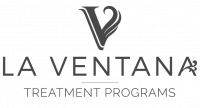
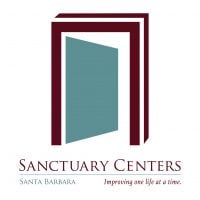
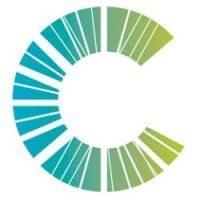
The facility name, logo and brand are the property and registered trademarks of The Bridge to Recovery, and are being used for identification and informational purposes only. Use of these names, logos and brands shall not imply endorsement. RehabNow.org is not affiliated with or sponsored by The Bridge to Recovery.

